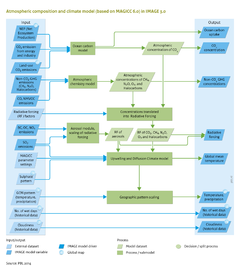Atmospheric composition and climate/Policy issues: Difference between revisions
Jump to navigation
Jump to search
Oostenrijr (talk | contribs) m (Text replace - "CO<sub>2</sub>" to "CO<sub>2</sub> ") |
Oostenrijr (talk | contribs) No edit summary |
||
| Line 1: | Line 1: | ||
{{ComponentPolicyIssueTemplate | {{ComponentPolicyIssueTemplate | ||
|Reference=Overmars et al., | |Reference=Overmars et al., 2014; Van Vuuren and Stehfest, 2013; Shindell et al., 2012; | ||
|Description=In baseline scenarios, emissions and greenhouse gas concentrations increase substantially. The increase in emissions depends on socio-economic factors, such as population growth, economic growth, technology development and lifestyle. Most medium baseline scenarios in IMAGE result in a rise in global mean temperature of about 3 to 5 °C above pre-industrial levels by 2100 (the figure below). | |Description=In baseline scenarios, emissions and greenhouse gas concentrations increase substantially. The increase in emissions depends on socio-economic factors, such as population growth, economic growth, technology development and lifestyle. Most medium baseline scenarios in IMAGE result in a rise in global mean temperature of about 3 to 5 °C above pre-industrial levels by 2100 (the figure below). | ||
|Example=Policy interventions that affect future climate range from policy on energy and agricultural systems, air pollution measures, and land-use policies to direct management of radiative forcing. For instance, the IMAGE system can be used to analyse energy efficiency, use of low-carbon fuels, reduction in non-CO<sub>2</sub> greenhouse gas emissions and reduction of deforestation ([[Overmars et al., accepted]]). Interventions related to policies on climate, air pollution and land use are described in Componens [[Climate policy]], [[Air pollution and energy policies]] and [[Land and biodiversity policies]], respectively. These measures lead to a change in emissions, and then to the expected reduction in radiative forcing and climate change. | |Example=Policy interventions that affect future climate range from policy on energy and agricultural systems, air pollution measures, and land-use policies to direct management of radiative forcing. For instance, the IMAGE system can be used to analyse energy efficiency, use of low-carbon fuels, reduction in non-CO<sub>2</sub> greenhouse gas emissions and reduction of deforestation ([[Overmars et al., accepted]]). Interventions related to policies on climate, air pollution and land use are described in Componens [[Climate policy]], [[Air pollution and energy policies]] and [[Land and biodiversity policies]], respectively. These measures lead to a change in emissions, and then to the expected reduction in radiative forcing and climate change. | ||
Revision as of 15:14, 7 October 2014
Parts of Atmospheric composition and climate/Policy issues
| Component is implemented in: |
|
| Related IMAGE components |
| Projects/Applications |
| Models/Databases |
| Key publications |
| References |
